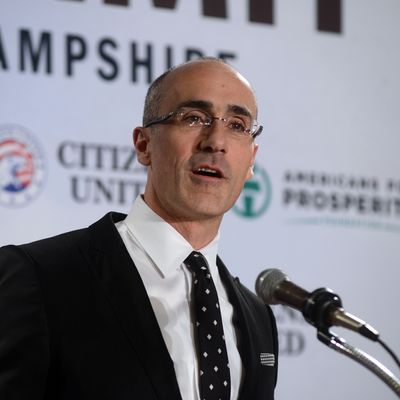
What did this week’s top two most-feminist-baiting opinion columns have in common? The ones about the so-called privileges of campus sexual assault and how women can avoid rape and abuse by getting married? For one thing, both found a home in the Washington Post. They also shared an infuriatingly sexist, belittling vocabulary: One put “sexual assault” and “survivors” in scare quotes; the other urged women to “stop taking lovers” and marry their “baby daddies.” But the most important similarity, as we look ahead to the future of misogyny in politics, is that both columns lean heavily on data furnished by the American Enterprise Institute (AEI) — a conservative think tank that’s enjoying a moment in the spotlight.
According to an April Newsweek profile, much of AEI’s recent influence has to do with Arthur C. Brooks, pictured, who has been its president since 2009. (A $20 million donation from a Roman Catholic founder of the Carlyle Group probably didn’t hurt, either.) “He’s the message man,” Pema Levy wrote of Brooks. “He may not be a pollster, but Republicans say he possesses a gift for making conservative policies sound appealing.” Newsweek focused on the ways Brooks is nudging conservatives toward less flagrantly uncompassionate policies on poverty. But, judging from these op-eds, the AEI is also employing the most sophisticated techniques to date in the much-discussed Republican “war on women.”
For starters, they’ve put a female face on it. AEI scholar and The War Against Boys author Christina Hoff Sommers has a new “vlog” series, “The Factual Feminist” (as opposed to us fantasy feminists), in which she seeks to invalidate feminist discourse. Like debunking this popular #yesallwomen tweet.
“First of all, what does that 10 percent figure represent?”
It’s a thought experiment, Christina.
“Are they saying 10 percent of men are rapists or murderers? What’s the evidence for that?”
This may not be the most incisive example of argument-by-fact-check — but in our age of mansplainers and data journalists, there is something especially insidious about a woman and self-described feminist like Sommers providing anti-feminist talking points. Her claim that “feminist activists have convinced many young women that a foolish, drunken hookup was actually rape” sounds a lot more credible than, say, Todd Akin’s “legitimate rape” distinction, despite meaning essentially the same thing: What women call rape isn’t really that big a deal.
That’s an idea the AEI seems committed to proving. George Will’s evidence that the “coveted status” conferred on campus rape victims has caused a “proliferation” of false accusations comes from the AEI’s Mark Perry. In a blog post, Perry set out to debunk the Department of Justice statistic that one in five women will be sexually assaulted during college by reverse-engineering it. He took the number of rapes reported at Ohio State University and used the rate at which women report their rape — 12 percent, another DOJ figure — to determine the “real” number of women who were sexually assaulted. He found that 1 in 34 women in the class of 2012 had been sexually assaulted during their time at Ohio State University — “too high, but not even close to the White House claim that one in five (and 20% of) female students are sexually assaulted while in college.”
It’s true that the Justice Department study sourced for the one-in-five statistic is probably too limited to be extrapolated to all college campuses. But Perry’s math also contains missteps. Looking more closely at the study, one sees that 12 percent refers to the rate at which women report forced sexual assault, what the authors define as assaults occurring “as a result of physical force or threats of physical force.” That does not include the much more common occurrence of incapacitated sexual assault, defined as “any unwanted sexual contact occurring when a victim is unable to provide consent or stop what is happening because she is passed out, drugged, drunk, incapacitated, or asleep.” In the DOJ study, only 2 percent of incapacitated sexual assaults were reported. Their numbers might account for Perry’s missing victims.
Tuesday’s Washington Post feminist bait, this time from the AEI’s W. Bradford Wilcox, relied on a similarly dodgy use of data. The piece’s misguided original headline is memorialized in its URL — “the-best-way-to-end-violence-against-women-stop-taking-lovers-and-get-married” — and while that headline was soon swapped out, the argument remained the same: “Married women are notably safer than their unmarried peers, and girls raised in a home with their married father are markedly less likely to be abused or assaulted than children living without their own father,” according to co-author Wilcox, whose byline identified him as “[directing] the Home Economics Project at the American Enterprise Institute and the Institute for Family Studies.”
FiveThirtyEight’s Mona Chalabi did the heavy lifting on debunking the claim that, statistically speaking, #yesallwomen could avoid being violently victimized by getting married. As Chalabi points out, married women tend to be whiter, more educated, wealthier, and older. The author of the Department of Justice study Wilcox cites told her that Wilcox should have controlled for these other variables, known to impact victimization rates — age, income, and education level, as well as the disparities between partners — before using the data to make prescriptions about marriage.
If this week is any indication, future anti-woman policies will be much more carefully dressed-up than the moronic revelations made by pro-life congressional hopefuls in 2012. Their advocates will make sensible appeals to our morals, in respectable publications, backed up with genderless “data.” It’s cathartic to watch outrage flare up on Twitter after these columns are published (at least for now), but — when it comes to these savvy, data-driven cases for sexist policy — it’s not nearly enough. FiveThirtyEight’s AEI takedown, however, makes the case for a new, feminist, non-burrito-related mission for the rising class of male-helmed explainer-journalism outfits.




